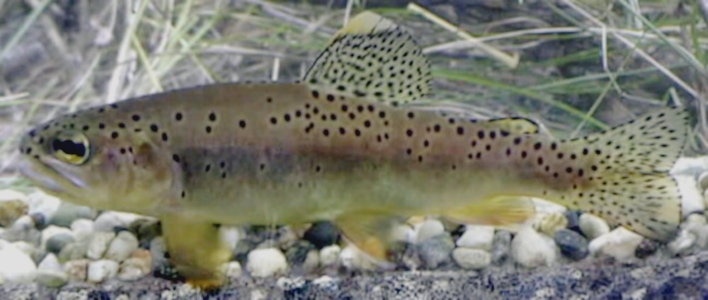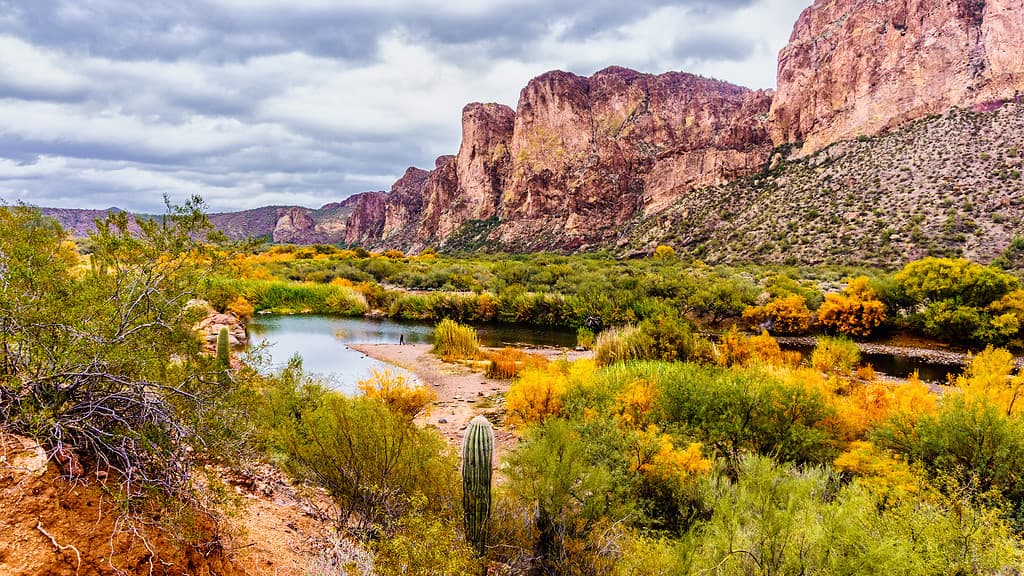Many states choose animals and plants to represent them. Sometimes, they’re animals that embody the state’s philosophy, and sometimes animals are chosen because they’re unique to the area. Arizona has many different state animals, including a state dinosaur!

The official state fish of Arizona is the Apache trout. That name may not sound familiar to people, including those that fish in the state. That is part of why the Apache trout is such a special animal. After all, the Apache trout is native as well as endemic to Arizona. They are not naturally found in any other state in the country, and they’re only found in certain parts of Arizona.
That means few opportunities exist to fish for Apache trout in the state, so it’s not often listed among the best fish to catch in Arizona. Not helping matters is that the fish was once endangered. The species faces many challenges that could reduce its population even though it was recently selected to be delisted from the Endangered Species Act.
The Apache trout has an olive-yellow body with a belly that ranges in color from yellow to gold. Most of the time, these fish measure between 6 and 20 inches long and weigh up to about 5.25 pounds. However, their size often depends on the place in which they’re raised. The members of this species that are raised in hatcheries tend to grow larger and weigh more than their wild counterparts.

The Apache trout has an olive-yellow body with a yellow to gold belly.
©U.S. Fish and Wildlife Service Headquarters / Public Domain – License
The Apache trout is found in mountain streams within the White Mountains that run through east-central Arizona. They are especially found in streams that run through forests and meadows. Typically, they are only found at high elevations in their limited range throughout the state.
Deciding Arizona’s State Fish

The Salt River contains a population of Apache trout.
©Harry Beugelink/Shutterstock.com
The Apache trout was made the state fish of Arizona in 1986. The fish is found nowhere else in the United States except for very specific parts of Arizona, so it made sense to honor this fish.
Before then, a quiet battle to protect the species was underway. The Apache trout was first granted protection under the Endangered Species Act in 1969, and that protection was renewed with the passing of the Endangered Species Act of 1973. The species’ population was declining for decades up until that point.
Apache Trout Conservation

Following six decades of efforts, the Apache trout is back from the cusp of extinction.
©renzedyk/Shutterstock.com
Historically, Apache trout had a range of over 600 miles throughout the streams that fed into the Little Colorado River, San Francisco River, and upper Salt River watersheds. That range stayed much the same until the early 20th century. However, the species’ population started to plummet due to overfishing, habitat loss, and the introduction of other fish species.
The latter was especially harmful. Originally, the state and federal governments planned to introduce new species of fish into the water to provide greater food sources for settlers in the area. Government entities introduced brown trout and brook to the streams where Apache trout lived, but those new fish started feeding on other fish in the waters.
Next, cutthroat and rainbow trout were added to the streams, and they began crossbreeding with the Apache trout, further diminishing their numbers. By the mid-20th century, Apache trout were only found in about 12 streams over 30 miles within the Fort Apache Indian Reservation.
Fortunately, the Fort Apache Indian tribe recognized the threat to the species and banned people from fishing for these creatures for sport in the Mount Baldy Wilderness Area starting in 1955. That preserved the original species of trout from intermingling with others while also cutting down on the number of fish taken each year. Following six decades of efforts, the species is back from the cusp of extinction.
Modern Threats to the Apache Trout

Wildfires present a serious threat to trout populations.
©iStock.com/MichaelPenhallow
Presently, the Apache trout is listed as critically endangered under the IUCN. However, the federal government has suggested that the fish be removed from the protection of the Endangered Species Act following a five-year review of the species.
The species now has about 30 genetically pure populations. Furthermore, the Apache trout have enough of a habitat for them to achieve self-sustaining populations. That does not necessarily mean that the fish is out of the woods as far as dangers to its population.
Significant threats exist to the official state fish of Arizona, including:
- Drought
- Wildfires
- Habitat loss
- Crossbreeding with rainbow trout and other non-native species
- Overfishing
The agencies that oversee the stocking and fishing of Apache trout must remain vigilant. Otherwise, the trout’s population could shrink again.
Where Can You Catch the Apache Trout?

The Little Colorado River is a tributary rising from the White Mountains that flows into the Grand Canyon.
©Wirestock Creators/Shutterstock.com
Anglers can catch Apache trout in areas throughout the state. These fish are stocked in parts of the Black River, the Little Colorado River, and Silver Creek. People can also fish for Apache trout at Lee Valley Lake. However, there are bag limits and special gear restrictions in place for some or all of these areas.
Anyone fishing for Apache trout would be wise to consult local officials about their preferred destination. That way, they do not to run afoul of any laws.
The Apache trout is still thriving as the official state fish of Arizona. The species is proof that human ingenuity, sacrifice, and hard work can bring species back from the brink of extinction. In this case, the fish can now be enjoyed by future generations thanks to the work of people in the past. Hopefully, this species continues to thrive forever in Arizona.
The photo featured at the top of this post is © Mariusz S. Jurgielewicz/Shutterstock.com
Thank you for reading! Have some feedback for us? Contact the AZ Animals editorial team.







